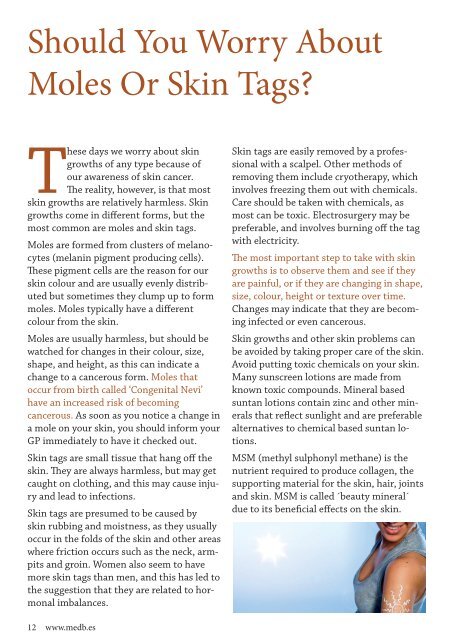Preventing Alzheimer's Disease and Stroke
There is strong clinical evidence that chronic diseases of the brain can be prevented and even reversed.
There is strong clinical evidence that chronic diseases of the brain can be prevented and even reversed.
Create successful ePaper yourself
Turn your PDF publications into a flip-book with our unique Google optimized e-Paper software.
Should You Worry About<br />
Moles Or Skin Tags?<br />
These days we worry about skin<br />
growths of any type because of<br />
our awareness of skin cancer.<br />
The reality, however, is that most<br />
skin growths are relatively harmless. Skin<br />
growths come in different forms, but the<br />
most common are moles <strong>and</strong> skin tags.<br />
Moles are formed from clusters of melanocytes<br />
(melanin pigment producing cells).<br />
These pigment cells are the reason for our<br />
skin colour <strong>and</strong> are usually evenly distributed<br />
but sometimes they clump up to form<br />
moles. Moles typically have a different<br />
colour from the skin.<br />
Moles are usually harmless, but should be<br />
watched for changes in their colour, size,<br />
shape, <strong>and</strong> height, as this can indicate a<br />
change to a cancerous form. Moles that<br />
occur from birth called ‘Congenital Nevi’<br />
have an increased risk of becoming<br />
cancerous. As soon as you notice a change in<br />
a mole on your skin, you should inform your<br />
GP immediately to have it checked out.<br />
Skin tags are small tissue that hang off the<br />
skin. They are always harmless, but may get<br />
caught on clothing, <strong>and</strong> this may cause injury<br />
<strong>and</strong> lead to infections.<br />
Skin tags are presumed to be caused by<br />
skin rubbing <strong>and</strong> moistness, as they usually<br />
occur in the folds of the skin <strong>and</strong> other areas<br />
where friction occurs such as the neck, armpits<br />
<strong>and</strong> groin. Women also seem to have<br />
more skin tags than men, <strong>and</strong> this has led to<br />
the suggestion that they are related to hormonal<br />
imbalances.<br />
Skin tags are easily removed by a professional<br />
with a scalpel. Other methods of<br />
removing them include cryotherapy, which<br />
involves freezing them out with chemicals.<br />
Care should be taken with chemicals, as<br />
most can be toxic. Electrosurgery may be<br />
preferable, <strong>and</strong> involves burning off the tag<br />
with electricity.<br />
The most important step to take with skin<br />
growths is to observe them <strong>and</strong> see if they<br />
are painful, or if they are changing in shape,<br />
size, colour, height or texture over time.<br />
Changes may indicate that they are becoming<br />
infected or even cancerous.<br />
Skin growths <strong>and</strong> other skin problems can<br />
be avoided by taking proper care of the skin.<br />
Avoid putting toxic chemicals on your skin.<br />
Many sunscreen lotions are made from<br />
known toxic compounds. Mineral based<br />
suntan lotions contain zinc <strong>and</strong> other minerals<br />
that reflect sunlight <strong>and</strong> are preferable<br />
alternatives to chemical based suntan lotions.<br />
MSM (methyl sulphonyl methane) is the<br />
nutrient required to produce collagen, the<br />
supporting material for the skin, hair, joints<br />
<strong>and</strong> skin. MSM is called ´beauty mineral´<br />
due to its beneficial effects on the skin.<br />
12 www.medb.es<br />
MedMag_Vol7.indd 12 05/11/2015 15:50:56

















